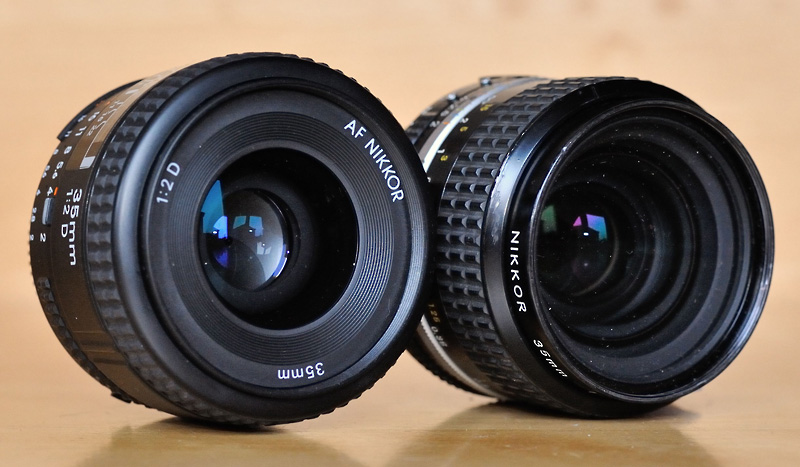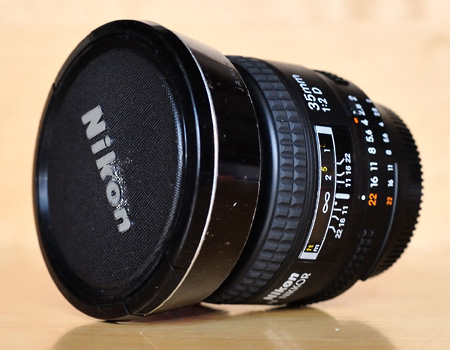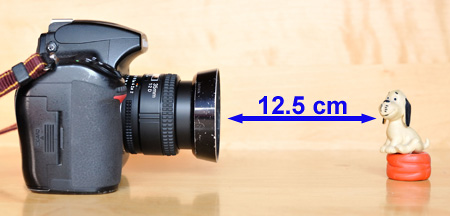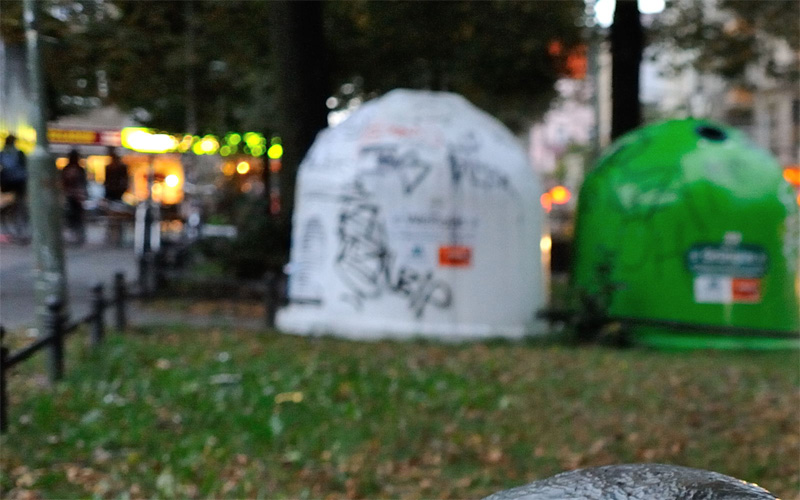
For many years - when my children were small - my Nikkor 35mm f/2 was the standard lens on my F4. A focal length of 35mm is great for going close to your subject without losing the context and without producing significant wide-angle distortions.

|
|
"Daddy, what's this"? My daughter with a small jellyfish on the beach of St. Peter-Ording, Germany in spring 2001. Captured on Fujichrome Sensia with Nikon F4 and Nikkor 35mm f/2. |
The 35mm f/2 was introduced in 1962 and instantly became a favourite lens for photo journalists. With only a few slight changes over the years this manual focus lens remained in the Nikon lens lineup until 2005.
In 1989 Nikon anounced the AF 32mm f/2 with only six elements in five groups (the MF lens has eight elements in six groups). It shares the same optical design with its successor, the 'D' version, introduced in 1995 and still in production. Some people reported oil on the aperture blades of the first (non-'D') version. I've never heard of such problems with the 'D' version.
Three months ago I bought a used AF Nikkor 35mm f/2 D for trying. This lens is much smaller than a 17-35mm or a 35-70mm f/2.8 and therefore much more inconspicuous. Besides, it is one f-stop faster than the f/2.8 zooms. Thus, it is a candidate for available light photography in the city, see sample images below.
Of course, I took my good old manual 35mm f/2 out of my cupboard for a little comparison. Overall the optical performance of the two lenses is very similar. But the newer AF-lens is slightly better in every respect.
In terms of build quality I see advantages for the full metal manual focus lens, but the AF-D lens seems to be solid too. Both lenses offer a nice manual focus feeling!

|
|
Size comparison: the AF-S 17-35mm f/2.8 with HB-23 hood, the AF 35mm f/2 D with HN-3 hood and the 35mm f/2 (AIS) with HN-3 hood. |

|
|
The front element of the AF lens is significantly smaller than the one of the MF lens. |

|
|
A 72mm front cap fits perfectly into the HN-3 hood! |

|
|
At closest focus (0.25 m) the distance between the front of the hood and the subject is about 12.5 cm and the magnification is about 1:4.4. |

|
|
Sale in Berlin. If you need reasonably sharp corners you have to stop down to F4 or beyond, see 100% crop below. Captured in September 2012 with the D700 at ISO 6400, F4 and 1/60 sec. |

|
|
100% crop of the lower left corner of the image above. |

|
|
A part of the sculpture ensemble "Die Begegnung" by Azade Köker which in turn is a part of the "Menschenlandschaft" (I would translate it to 'human landscape'), a sculpture project in Kreuzberg, Berlin. Nikon D700 at ISO 800, F2 and 1/25 sec. Even wide open the AF 35mm f/2 D is pretty sharp and contrasty in the centre. But the bokeh is very nervous. |

|
|
Another ensemble of the "Menschenlandschaft" is „Dove Vai“ by Andreas Wegner. Captured with the D700 at ISO 3200, F4 and 1/50 sec. Even at F4 the bokeh is nervous, see the crop below. For instance, the AF-S 17-35 gets a smoother bokeh when stopping down a bit. |

|
|
Crop from the upper left corner of the above image at 50%. |

|
|
Bob is cycling along the avenue... Berlin, September 2012. Nikon D700 at ISO 3200, F4 and 1/50 sec. |